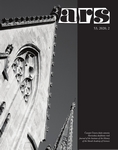
Journal ARS 53 (2020) 2
Zoltán Bereczki
The Single Gothic Towers of the Two Franciscan Churches of Bratislava and Sopron and Their Possible Connections to Vienna
(Summary)
The openwork spires with their height and technical quality are the most advanced building parts of the Gothic architecture. Their first representant was constructed in Freiburg im Breisgau (completed around 1330), and it soon became a general archetype. The south tower of St. Stephen’s church in Vienna was completed in 1433, and with its 137-meter height it was the tallest stone spire of its time. The Viennese tower had significantly improved upon the Freiburg one not only artistically, but structurally as well. This improvement did not happen in one single step. Two smaller Gothic towers in the onetime Kingdom of Hungary represent two important stages of this evolution: the one of the Franciscan monastery in Bratislava, and the one of the Franciscan (now Benedictine) monastery in Sopron. For the Bratislava tower the dating of 1400 is widely accepted by the secondary literature. Through the on-site examination of the masonry of the St. John’s chapel next to the Franciscan church evidence was obtained that it was built in only one campaign, and was completed in a short period of time. It can be dated accurately using a written source from 1361. During the on-site research several similarities were found between the chapel and the tower – some of them in detail –, so their building time could not be far from each other. Analysis of the motifs, forms of the tower also buttresses an earlier dating than 1400. Both the tower and the chapel share similarities in layout, forms, and stonemasons’ marks to parts of the St. Stephan’s church completed during the reign of Rudolf IV (1358–1365). The personal connection to Vienna seems to be a business partner of judge Jacob, who is regarded as a donator of the chapel. The similarities of the Bratislava chapel and tower to the contemporary parts of the St. Stephen’s church hint that the workshop of Rudolf IV, the so called Herzogswerkstatt was active in Pressburg too. There aren’t any survived contemporary sources available about the construction of the Sopron tower. The construction date between 1380–1410 is accepted in the literature. This dating by Jenő Házi from 1961 is based on his assumption that Heinrich Gaissel was the donator. According to the later literature, the donator was his brother, Nikolaus Gaissel, who was judge of Sopron as early as 1361, and in 1366 he inherited a fortune. As the donation, so the layout, formation, and forms of the tower do not justify the late dating. The unusual layout of the tower – situated next to the nave, with a portal on its ground floor, shaping a new north-south axis to the church – is the same as the layout of the Viennese south tower, going back to Rudolf IV. A distinctive element of the Sopron spire is its stone gallery near the top. Similar galleries are shown on original glass paintings of the Viennese choir, dated to 1340–1350. The Viennese connections also manifest themselves in the person of the donator: the brother-in-law of Nicolaus Gaissel was judge in Vienna. Further parallels in style can be identified in the St. John’s chapel and the Franciscan tower in Bratislava. Since the architectural parallels are originated in the middle of the 14th century, and the large heritage of the donator dates to 1366, the second half of the 1360’s seems to be the most plausible building time, and the builders could be the members of the St. Stephen’s lodge, as in Bratislava. Tim Juckes proved that during the long construction history of the St. Stephen’s nave several innovations of the lodge were realised earlier outside of Vienna (occasionally in the Kingdom of Hungary) then on the St. Stephen’s church itself. The situation seems to be similar during the several decade long construction of the south tower: the most important architectural components, which distinguish it from the paragon Freiburg tower can be found on smaller, older towers in Vienna and its neighbourhood. The literature connects the towers in question (Gaming, Maria Straßengel, Deutsch-Altenburg, Maria am Gestade) to the lodge of the St. Stephen’s church. Both the Bratislava and the Sopron tower fit perfectly in their series. Both towers are closely tied to the Vienna lodge, and on both tower appear components which are not present in Freiburg, but are important features in the appearance of the Vienna tower. These components were realised in Bratislava and Sopron earlier than in Vienna.